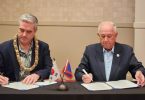THINGVELLIR, Iceland — In Iceland’s Thingvellir national park, a wooden bridge covers a crack in the paved road leading to the site where the world’s oldest parliament was founded in 930.
But the bridge is considerably younger, only dating back to last summer. It was built after a few hundred metres (yards) of tarmac road almost collapsed, buckling under a steadily growing stream of visitors.
A hole in the ground revealed that the road was merely built on layers of sand that could have collapsed at any moment. The discovery averted a tragedy at this UNESCO World Heritage site 50 kilometres (30 miles) from Reykjavik, but illustrates the challenges faced by Iceland’s hugely successful tourism sector.
The North Atlantic island, known for its rugged beauty, has seen a rapidly growing influx of tourists in recent years. Last year, they numbered 672,000, or 19 percent more than the previous year, and twice as many as in 2003.
“It’s a challenge to have 20 percent growth each year. Every industry would be challenged to experience such a development,” said the director general of the Icelandic Tourist Board, Oloef Yrr Atladottir.
Singer Bjork’s success in the 1990s, the banking crisis of 2008 and the eruption of the Eyjafjallajoekull volcano in 2010 are all events that — for good or bad — have boosted the country’s profile abroad.
Attractions range from the azure waters of the Blue Lagoon geothermal spa to lesser-known yet spectacular sites like the heart of the dormant Thrihnukagigur volcano.
“We came to Iceland to see what this country is really like. To see something different: geysers, lava fields, hot springs,” said British tourist Leon Jones, 37.
Once the preserve of wealthy travelers looking for a quiet retreat, the country has become a significantly more affordable destination after the collapse of the Icelandic krona, which has never recovered after losing 47 percent of its value against the euro in 2008.
But some are starting to ask how many tourists the tiny nation can handle.
“Since 2011 we’ve been focusing our marketing campaigns on the off-season period,” said Atladottir. Those efforts have pushed the ratio of visitors who arrive in summer to below 50 percent.
“Now we have to define where we want tourism to grow…. During the high season, there are certain areas that cannot bear many more tourists,” she added.
But David Samuelsson, chief executive of Visit South Iceland, says he believes the country could do even better when it comes to catering to visitors looking to go off the beaten track, and is calling for the tourist trade to become more local.
“The two main reasons why people come to Iceland are one, nature, and two, nature. So we’re trying to convince them to come closer to this nature as soon as they arrive, which for example some farmers offer,” he said.
Although the country has seen a tourism boom, it has also invested a lot in the sector, he added.
“Yes, business has been very good. But a lot had been invested. Icelanders took foreign loans before the crisis. They had to succeed,” he said.
Tourism has also become a crucial source of foreign currency after Iceland imposed capital controls in the wake of the 2008 crisis.
Consequently, even as it suffered through its worst recession since independence from Denmark, Reykjavik’s leisure and hospitality sector thrived.
Growth came across the board, whether in luxury hotels or youth hostels, family-run businesses offering glacier tours, or large companies chartering boats for whale watching.
The most eye-catching project was arguably that of Chinese real estate developer Huang Nubo, who wanted to buy a large swath of Icelandic wilderness in the country’s northeast to build a resort and create Europe’s largest nature reserve.
However, the government vetoed the project in 2011 amid concerns over the amount of land involved.
The leftist coalition that ruled the country for the past four years — which was voted out of office in elections Saturday — is unlikely to be missed by the sector, Samuelsson said.
“It didn’t make things easier (for us) with its tax policy,” he said.






















